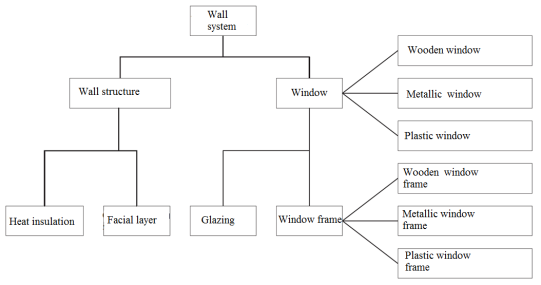The purpose of classification is to divide the items into collections. Consequently, in order to classify a collection of objects, the first step is to define the purpose of this classification, then necessary to highlight the characteristics of greatest interest, and finally, the objects may be sorted into classes based selected properties. The purpose of the classification system is to organize concepts and terms in a certain area, it thus provides a basis for distinguishing between objects. The classifications of objects grouped into different classes, wherein each class is a collection of members, and is determined in accordance with characteristics relating to the classification. Characteristics that define the classes used in determining each class. This definition should be expressed in text form. Classes can be arranged through the levels from general to specific. Features classes in high standing levels are common, and in lower levels are specialized sets combined in the collection.
Key words: Classifier, library,hierarchy, BIM.
Building information modeling and modern forms construction project requires the use of classification systems of building objects. Construction BIM in particular is the exchange various types of information between project participants and stakeholders throughout the project development time. This also applies to the unification of the forms of realization of the construction project. For successful implementation of the exchange, it is necessary to complete and a consistent approach to the classification of objects of construction It is carried out within the project and between projects.
The following types of information exist: geometry data, functional and technical specifications, cost data and data maintenance. It covers the full project life cycle from inception to disposal. Participants of project: clients, designers, authorities, designer, users and operators.
The main reason for the design of building complexes and building of objects is a need for them. Data collection on the field of activity of users and functional requirements is an important part of the information required in the construction process. However, the classification in accordance with the area of activity of users goes beyond the standards. Different classes considered in the standards associated with the main (core) process model, which is based on the fact that in the construction process, to achieve a certain result of the construction, use specific building resources. This is the basis for the formation of the class structure of greatest interest. [1]
The classification and composition.
Classification systems, in addition to the distribution of the specialization (classes and subclasses), may also be distributed in accordance with the composition provided they have the information and the name of the structuring composition (Figure 1.).
As an illustration, consider Figure 2. It can be seen that the wall insulation and air duct insulation belong to the class under the name "insulation", but at the same time they can be part of wall-system and therefore the ventilation system.

Fig. 1. Illustration of the hierarchy of the classification and hierarchy of the structural composition

Fig. 2. Illustration of the structural composition and classification
Classification
The purpose of classification is to divide objects into groups according to their characteristics of interest. Classes are defined by attributes that describe these characteristics. First of all, characteristics common to the entire group must be accurately determined. Standing at the head of the class is the most common classification. Then, this class may be divided into more specialized classes in several phases, according to the characteristics of interest. The division into classes extends from general to specific. The classes are organized by level, type-of-defined ratio, where detailed classes are part of more general classes. Classified objects are elements of classes.
Type-of relation — the relationship between the two concepts, where the area of one of the terms includes the area of another concept and at least one additional restraining characterization. [2,3]
Systems and structure composition.
The main idea of the system is not associated with any particular region, but is used in a broad sense. All objects can be viewed as a system. Systematic approach allows the designer to deal with the full (complex) information (as opposed to partial information). Relationship between the systems are determined and monitored by identifying the interconnected systems, for example, to make sure all systems are working properly. Examples of relations are a contribution or impact in their natural environment system.
Example: carrier system, roof system, wall system, ventilation and air conditioning system, drainage system, electrical system, communication system, transportation system, the system of planting, color system, the hospital system, ecosystem, landscape system, repair system, control system, the education system, windowing system, the system loops, ventilator system, the factory system, procurement system.
Part-of relation — the relationship between the two building objects, where one object is a whole, and the other — part of the whole. [2,3]
Systems may consist of various subsystems in composite levels. When the division into sub-parts or structuring systems into subsystems, using part-of relationship, large sets of information in a complex design can be divided into smaller parts. Structuring the composition, thus giving a full view of the system in general, that for example, you need to understand the processes of establishing and changing. The total system, headed by another system, integrates all a lot of them to meet the challenges that each individual in the system is able to handle not. The subject is a part of, if you add or remove when it is added to the whole, the whole remains intact.
Units may vary in dimensions. Depending on the various aspects may be part-whole relation, for example:
– using a functional aspect of the function, it is fundamental for a function;
– using a spatial dimension, spatial expansion is a component of the spatial expansion of the whole;
– when using an assembly perspective, part-whole relation means that the appearance of the physical precedes the appearance of the whole.
Structuring principles set the stage throughout the life cycle, the need for the use of different structures based on various aspects of systems of interest.
Classification tables
As a result, unit class into subclasses according to their specialization receive classifications table. If the second principle of specialization is important for a particular class, it is used separately, and also a new classification structure developed. The subject must belong to only one class. For example, if the object is classified as a construction site, it cannot be classified at the same time as the construction industry. In the table, the object must be classified only once. The choice for many classification tables is shown in Table 1, which gives you some flexibility classifiers. Table 1 specifically identified the necessary principles of specialization, to determine the appropriate look-up table. As required, the tables are for use in combination or separately, depending on the need. [4]
Table 1
Specialization principles applicable to classes of objects
|
Class |
Classification in accordance with |
|
CLASSES ASSOCIATED WITH RESOURCES |
|
|
Construction information |
Content |
|
Construction product |
Function or the shape or material, or any combination of them |
|
Executor |
Discipline or role, or any combination of them |
|
Supporting resources |
Function or the shape or material, or any combination of them |
|
CLASSES ASSOCIATED WITH PROCESS |
|
|
Management |
Management activities |
|
Construction process |
Construction activity and the construction process of the life cycle, or any combination of them |
|
CLASSES ASSOCIATED WITH THE RESULT |
|
|
Construction complex |
Form and function, or activity of the user, or any combination of them |
|
Construction entity |
Form and function, or activity of the user, or any combination of them |
|
Built space |
Form and function, or activity of the user, or any combination of them |
|
Construction element |
Form and function, or position, or any combination of them |
|
Work result |
Work activity and used resources |
|
CLASSES ASSOCIATED WITH PROPERTY |
|
|
Construction property |
Type of property |
Name of the tables listed in this article are presented as recommendations, examples, and their sequences are given only for informative purposes and are not comprehensive.
References:
- ISO 12006-3, Building construction — Organization of information about construction works — Part 3: Framework for object-oriented information
- ISO 704, Terminology work — Principles and methods
- ISO 1087-1:2000, Terminology work — Vocabulary — Part 1: Theory and application
- ISO 22263, Organization of information about construction works — Framework for management of project information







